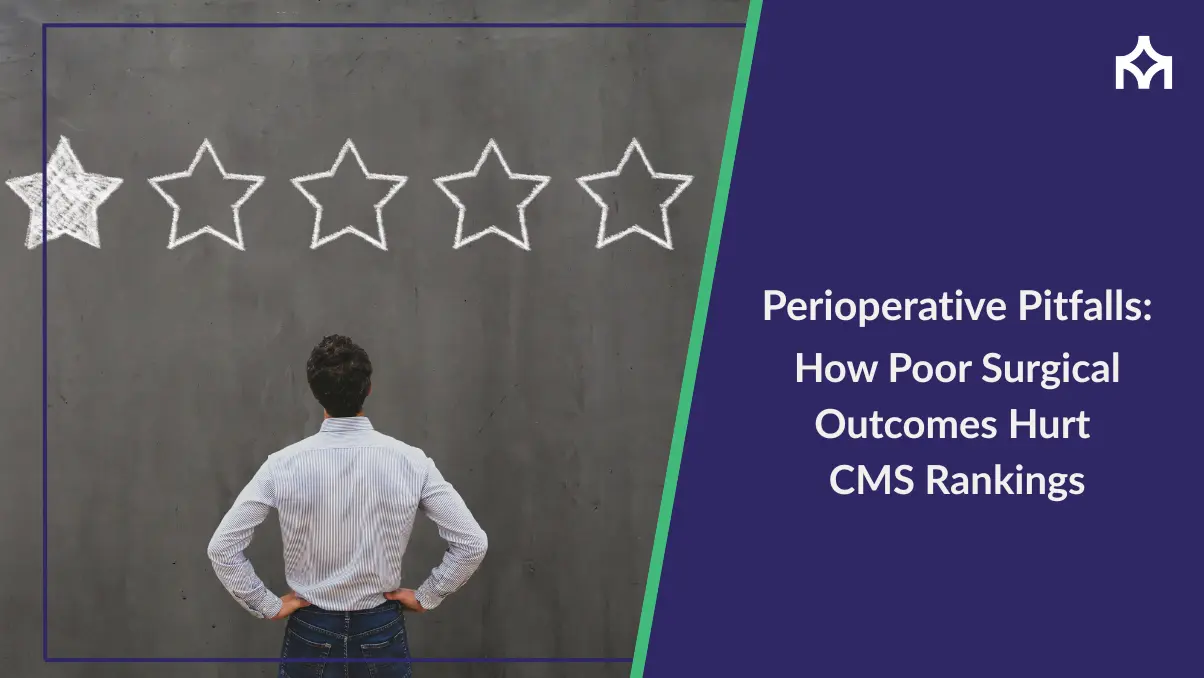As U.S. healthcare moves deeper into the era of transparency and value-based reimbursement, hospitals are under unprecedented pressure to deliver safe, efficient surgical care. The stakes are high: in 2025 alone, over 820 hospitals experienced CMS rating drops due to poor surgical outcomes and readmission rates. Meanwhile, CMS penalties tied to hospital-acquired conditions and readmissions have surged past $2 billion annually, with some hospitals losing millions in incentives for a single star rating downgrade.
In this environment, even one avoidable infection, readmission, or prolonged length of stay can spiral into a measurable financial hit, reputation damage, and patient trust erosion. This is especially true in the perioperative phase, where complications from pre-op risk mismanagement to post-op discharge gaps can silently erode quality scores.
Perioperative pitfalls are no longer just clinical missteps; they are strategic liabilities affecting your hospital’s CMS star ratings, payer negotiations, and public reputation. But there’s good news: these outcomes are predictable and preventable.
The Rising Influence of CMS Ratings
The Centers for Medicare & Medicaid Services (CMS) star rating system has become the gold standard for hospital quality in the U.S. Patients use it to choose care, insurers use it to design networks, and hospitals live or die by their placement on it.
But there's a catch: surgical outcomes carry disproportionate weight.
According to recent CMS data:
- Over 820 hospitals in 2025 saw their ratings drop due to unfavorable surgical outcomes and readmissions.
- CMS penalties related to value-based purchasing and HACs (hospital-acquired conditions) now exceed $2 billion annually.
- Even a 1-star drop can result in millions in lost Medicare reimbursements and damage to a hospital’s reputation.
Where the Perioperative Pitfalls Begin
The perioperative continuum is riddled with vulnerable points where small lapses can lead to large consequences:
1. Inadequate Preoperative Risk Assessment
Patients with unmanaged comorbidities are far more likely to experience complications. When hospitals fail to optimize these patients pre-surgery, CMS metrics take a hit through readmissions and higher mortality.
2. Protocol Deviations and Communication Gaps
Non-compliance with evidence-based protocols and poor interdisciplinary handoffs increase the risk of surgical site infections (SSIs), anesthesia errors, and intraoperative complications.
3. Delayed Complication Management
Delayed detection and intervention for postoperative issues like bleeding or infection often prolong hospital stays directly penalized under CMS efficiency measures.
4. Disorganized Discharge Planning
When patients leave without clear follow-up or medication guidance, readmissions spike—one of the most heavily weighted CMS metrics.
How Poor Surgical Outcomes Drag Down CMS Rankings
CMS uses risk-adjusted, real-time data to determine its star ratings. A few poor outcomes in high-risk areas like surgery can disproportionately hurt a hospital’s score:
| Surgical Pitfall | Impact on CMS Rating | Key Metric Tracked |
|---|---|---|
| Surgical Site Infections (SSIs) | Reduces patient safety and outcome scores | SSI rate per 100 procedures |
| 30-day Readmissions | Heavily weighted in star calculation | Readmissions post-CABG and ortho surgeries |
| Excess Length of Stay (LOS) | Hurts efficiency and quality scores | LOS vs national benchmarks |
| Post-op Mortality | Directly lowers overall hospital rating | Procedure-specific mortality rates |
| Poor HCAHPS Scores | Hurts patient experience metrics | “Would recommend” and communication scores |
Hospitals with frequent perioperative complications are three times more likely to land in the bottom quartile of CMS rankings.
How MGA Helps Hospitals Stay Ahead
Enter Modality Global Advisors—a data-driven transformation partner helping hospitals predict, prevent, and outperform when it comes to perioperative care.
MGA empowers surgical programs with tools and insights to:
- Real-Time Risk Stratification: Using EHR, claims, and device data, MGA flags high-risk patients before surgery to ensure better optimization and tailored care plans.
- Protocol Compliance Monitoring: By tracking adherence to surgical pathways like ERAS, MGA highlights variations and missed steps before they impact outcomes.
- Complication Surveillance Powered by AI: MGA uses machine learning to detect early signs of trouble such as post-op fever or abnormal labs before the complication escalates.
- Automated Patient Follow-Up: MGA ensures patients receive timely check-ins, medication reminders, and remote monitoring—significantly reducing 30-day readmission risk.
- Performance Benchmarking: Custom dashboards allow leadership to compare perioperative KPIs across service lines, pinpoint underperforming areas, and act swiftly.
The Result?
Hospitals working with consulting firms report:
- 25% reduction in surgical readmission rates
- Improved LOS benchmarks across orthopedic and oncology pathways
- Higher HCAHPS scores driven by better post-op communication
- Measurable improvements in CMS star ratings within 12 months
Conclusion: Fix the System, Elevate the Score
Poor surgical outcomes are more than just clinical issues; they are strategic liabilities in a healthcare system where every percentage point counts. But they're also the greatest chances for change, given the correct resources and direction.
Hospitals can stop responding to CMS penalties and begin actively influencing their rankings by investing in perioperative optimisation using MGA's data-backed methodology.
High-performance surgical treatment is not solely dependent on better surgeons. More intelligent systems are the focus. Additionally, MGA is helping with their building.

